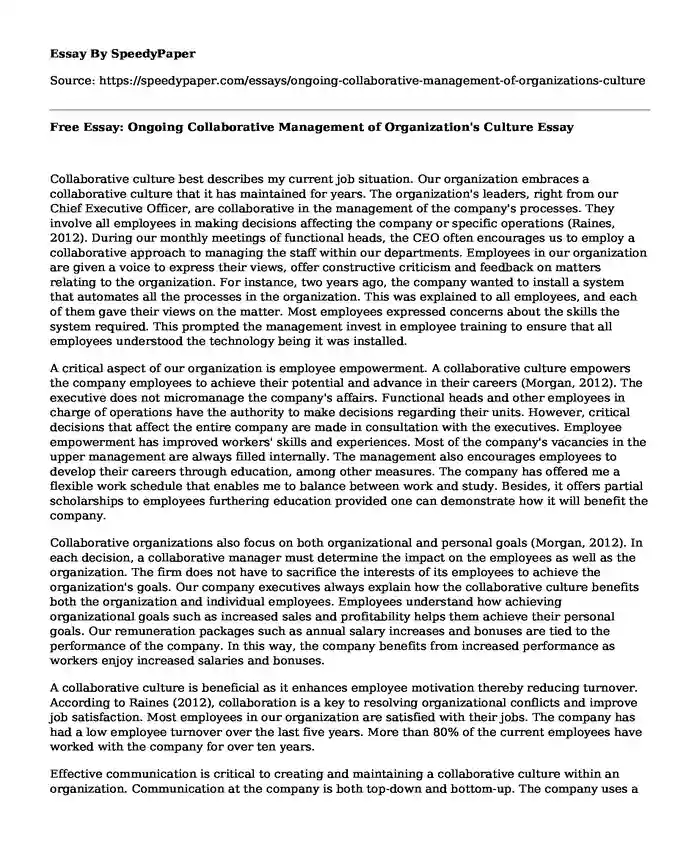
| Type of paper: | Essay |
| Categories: | Management Organizational culture |
| Pages: | 3 |
| Wordcount: | 670 words |
Collaborative culture best describes my current job situation. Our organization embraces a collaborative culture that it has maintained for years. The organization's leaders, right from our Chief Executive Officer, are collaborative in the management of the company's processes. They involve all employees in making decisions affecting the company or specific operations (Raines, 2012). During our monthly meetings of functional heads, the CEO often encourages us to employ a collaborative approach to managing the staff within our departments. Employees in our organization are given a voice to express their views, offer constructive criticism and feedback on matters relating to the organization. For instance, two years ago, the company wanted to install a system that automates all the processes in the organization. This was explained to all employees, and each of them gave their views on the matter. Most employees expressed concerns about the skills the system required. This prompted the management invest in employee training to ensure that all employees understood the technology being it was installed.
A critical aspect of our organization is employee empowerment. A collaborative culture empowers the company employees to achieve their potential and advance in their careers (Morgan, 2012). The executive does not micromanage the company's affairs. Functional heads and other employees in charge of operations have the authority to make decisions regarding their units. However, critical decisions that affect the entire company are made in consultation with the executives. Employee empowerment has improved workers' skills and experiences. Most of the company's vacancies in the upper management are always filled internally. The management also encourages employees to develop their careers through education, among other measures. The company has offered me a flexible work schedule that enables me to balance between work and study. Besides, it offers partial scholarships to employees furthering education provided one can demonstrate how it will benefit the company.
Collaborative organizations also focus on both organizational and personal goals (Morgan, 2012). In each decision, a collaborative manager must determine the impact on the employees as well as the organization. The firm does not have to sacrifice the interests of its employees to achieve the organization's goals. Our company executives always explain how the collaborative culture benefits both the organization and individual employees. Employees understand how achieving organizational goals such as increased sales and profitability helps them achieve their personal goals. Our remuneration packages such as annual salary increases and bonuses are tied to the performance of the company. In this way, the company benefits from increased performance as workers enjoy increased salaries and bonuses.
A collaborative culture is beneficial as it enhances employee motivation thereby reducing turnover. According to Raines (2012), collaboration is a key to resolving organizational conflicts and improve job satisfaction. Most employees in our organization are satisfied with their jobs. The company has had a low employee turnover over the last five years. More than 80% of the current employees have worked with the company for over ten years.
Effective communication is critical to creating and maintaining a collaborative culture within an organization. Communication at the company is both top-down and bottom-up. The company uses a range of collaborative tools such as social media to encourage communication and sharing ideas among executives and employees. Businesses can use collaborative tools to solve internal challenges by creating a healthy relationship between the company and its employees and among employees (Morgan, 2012).
Finally, shared vision and purpose are vital to ensuring a collaborative culture within an organization (Morgan, 2012). Collaboration cannot be successful if employees and the organization do not have a shared vision. When I joined the company, I passed through a rigorous induction process where the company executives explained to the organization's vision and how I can contribute to it. Every new employee undergoes this procedure to ensure his or her vision does not conflict with that of the organization. Employees understand how the organization's success positively contributes to their personal goals.
References
Morgan, J. (2012). The collaborative organization. New York: McGraw-Hill.
Raines, S. (2012). Conflict Management for Managers: Resolving Workplace, Client, and Policy Disputes. John Wiley & Sons.
Cite this page
Free Essay: Ongoing Collaborative Management of Organization's Culture. (2022, Mar 04). Retrieved from https://speedypaper.com/essays/ongoing-collaborative-management-of-organizations-culture
Request Removal
If you are the original author of this essay and no longer wish to have it published on the SpeedyPaper website, please click below to request its removal:
- Analysis of Airbnb Business Model. Essay Example.
- Employee Wellness Programs - HRM Essay Example
- Research Paper Sample: Obesity Trends among Low-income Earners
- "The Opaque Shine of Jewels" - Literary Essay Sample
- Analysis Of "The Negro Speaks Of Rivers". Your Free Essay Example
- Essay Sample on Coca-Cola and Oligopoly
- Essay Sample on FIFO (First-In, First-Out) and LIFO (Last-In, First-Out)
Popular categories




